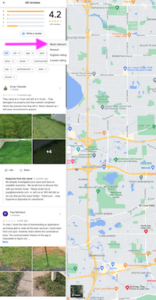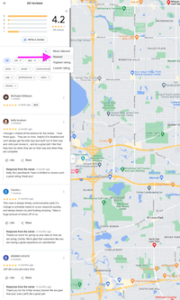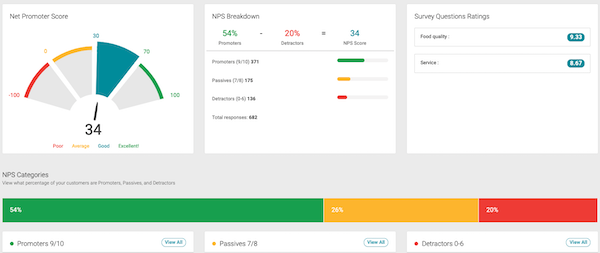Localogy is a conference for “SaaS companies, agencies, media, and brands shaping the products, services, and conversations that will drive SMB growth over the next decade.”
We heard from some of the best and brightest in local marketing and SaaS. It was great discussing ways to improve our product and processes that will delight more GatherUp customers.
Read on for our recap of Localogy and what it means for you.
Takeaway #1: Visual search is here and growing
Google is becoming incredibly accurate at determining how an image relates to a search query. Companies like Dall-E use artificial intelligence to create images based on provided text.
Much like text, title tags and schema, images are now being crawled to determine the best search result for a query. Businesses and agencies should keep Google’s algorithm in mind when it comes to using images in Google Business Profile and on websites.
Eoghan Geoghegan, SVP of Business Development at Aircam.ai, along with PatientPop Medical, presented compelling reasons to incorporate more images into your SEO strategy. Geoghegan laid out compelling evidence when it comes to using images to drive lead growth, both online and offline, when using images or photos. Using tools like Google Vision can help determine the best image for a specific category or search.
Pages or listings with quality images that more clearly portray a product or service to Google will not only rank higher but will also be attractive to prospective customers who will stay in the consideration phase longer.
What does this mean for you?
Using relevant, SEO-ready images in your marketing will take your local marketing to the next level. Visual search is becoming more important every day. GatherUp co-founder Mike Blumenthal recently wrote a 3-part series on this topic for Near Media.
It appears that Google even believes reviews with images carry more relevance than reviews without images, or recent reviews. Notice reviews with images show up when sorted by “Most Relevant” first.


How can you leverage GatherUp for visual search? Incorporate Social Sharing to regularly post images on your GBP and other social channels. Post Social Share images on your site as well, but make sure the content AND image are relevant.
For example, a dental practice could use Google Vision to find the best image for depicting a dentist. Their practice could use the image as the background of their Social Sharing image with a review that mentions how amazing, friendly or helpful the dentist was. The result is text AND an image designed for SEO and to build trust with potential patients.
The above contains text about menu items, and images of those items in the background could be picked up by Google’s visual search algorithm.
It’s possible one day customers could add an image to their feedback or use AI to create an image based on the context of the review. How would that image be displayed in a review widget and where would those images be stored? Interesting questions as we consider the value of images in local search.
Takeaway #2: A cookie-less future means more reliance on 1st party data
More than a few speakers at Localogy brought up the demise, or rapid change, of 3rd party data. So naturally the conversation moved to 1st-party data, which you own, or 0-party data. Zero-party data is data that is proactively given to a brand.
Owning customer data lets you market to customers without having to look to outside, 3rd party sources for reliable data. Consider your customer journey, and work to bring more people into the journey at the upper funnel. From there you can market more effectively to those people.
However you collect 1st- or zero-party data, be it lead acquisition through a website, or app usage or downloads, you’ll have a closer connection to the consumer.
What does this mean for you?
Collecting direct customer feedback is your way to own 1st-party data. A diverse set of customer reviews is important, but 1st-party reviews are going to be more important than ever.
If a customer leaves a review on Google, that is Google’s data. Sure you can monitor it, respond to it, or display it on your website. But Google could change something tomorrow, and you’d lose all the power that review had for your business.
However, when you own and validate 1st-party reviews you are in control. This feedback, and all the insights you gain from it, are yours.
Build out an email list of Promoters to incentivize repeat visits.

Create a segment from all your restaurant patrons who left a review mentioning “tacos” and send them a taco special once a week to increase visits.

Another path to owning more 1st-party data would be to use a messaging application to create a smoother customer experience. All the conversations, lead generation opportunities and service questions can be answered in a timely fashion, but you’ll also harness key customer journey data points to be used for marketing, CS, operations and other departments.
Having communication, support, feedback all in one place allows you to continue improving your product, service or customer experience…which leads us to our final takeaway.
Takeaway #3: Customer experience is the backbone of every business
We’ve been saying it for a while, but this mantra was reinforced at Localogy. Much of this focus is due to how the pandemic changed business the past two years.
Florian Hubner, CEO of Uberall, when talking about Uberall’s hybrid customer experience, said “businesses need to compete on experience.” Price, value, speed, etc. are tough to compete on. But when a person searches for a business, they read reviews to see what that experience is like. They are looking for an authentic or sincere experience.
Delivering a positive customer experience helps businesses get found, be chosen and drive loyalty. In today’s world that means everything from reputation to website, to first customer touchpoint, to sale and even billing/payment.
Think about the businesses you’ve visited online. You found the product you wanted, and the shipping times were speedy. It seemed perfect.. . But then payment was a struggle. How does that make you feel as a customer? That’s the last touchpoint you remember, and if it’s a hassle, you may go elsewhere next time.
What does this mean for GatherUp customers?
GatherUp has been making customer experience the backbone of every business for years. Businesses who use our features to their fullest extent get the most out of the product and build a customer experience hub, not just a review tool.
How can you create a customer experience hub?
- Send out feedback requests based on the optimal time to receive feedback, i.e. if you’re an auto dealer wait a couple days for the customer to enjoy the new car.
- Set KPIs around responding to feedback quickly. Bar Louie’s Kayla Dylan said 60% of Bar Louie locations meet their KPI of responding to every review within 48 hours. It’s part of their normal operations. GatherUp’s Inbox makes it easier to organize your responses
- Collect 1st party feedback and 3rd party online reviews from the most important sites. Ask for feedback at different points within the customer journey. Net Promoter Score can bucket your customers for easy email campaigns based on promoters, passives and detractors.
- Set up Auto-Tagging so your have quantifiable data showing what drives a positive or negative experience. Then you amplify the positive or correct the negative.
- Be authentic in your marketing. Showcase the full customer experience by displaying all your reviews on your website. As Christian Ward from Yext noted, “93% of customer journeys start with a search.” Leverage your online reputation so it can be seen by people searching for your product or service
- Let customers provide feedback in their preferred channel. This could be SMS, email requests, TextBack, an onsite table tent, QR code, or a link on their invoice.
- Measure the experience. Continue to monitor NPS, review ratings, survey questions and sentiment to better understand your customers, their pain points, what delights them and more.
Summary
We continue to iterate on the promise of helping businesses listen and interact with their customers. Customer experience has never been more important.
Prepare for a future of visual search by optimizing and leveraging images in your marketing. Own your 1st-party and zero-party data and use it to your marketing advantage. Always choose the customer-focused approach.
Do these three things, and you will continue to provide positive customer experiences. Your online reputation will reflect that, and you will keep winning new customers.
